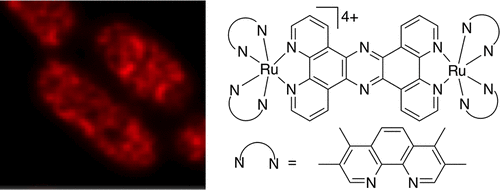博文
新发现的化合物可以杀死耐抗生素的超级细菌
|||
新发现的化合物可以杀死耐抗生素的超级细菌
诸平

Gram negative bacteria. Credit: University of Sheffield
据谢菲尔德大学(University of Sheffield)2019年5月28日提供的消息,谢菲尔德大学和卢瑟福·阿普顿实验室(Rutherford Appleton Laboratory, RAL)的科学家发现了一种新的化合物(Ru的配合物见图1),它可以可视化并杀死耐抗生素的超级细菌。


这个由谢菲尔德大学化学系的吉姆·托马斯教授(Professor Jim Thomas)领导的研究小组,正在测试由他的博士生克斯蒂·斯密特(Kirsty L. Smitten)开发的新化合物,对包括致病性大肠杆菌(E. coli)在内的耐抗生素革兰氏阴性菌(Gram-negative bacteria)的耐药性。革兰氏阴性细菌株可引起包括肺炎、尿路感染和血液感染在内的感染。它们很难治疗,因为细菌的细胞壁阻止药物进入微生物。由于日益严重的抗药性,许多抗生素已失去往日的辉煌,如青霉素等。而且对于革兰阴性菌,如使用抗生素不当,会加重病情的发展。因为革兰阴性菌的多聚糖外还有一层外膜,外膜由特异多糖,核心多糖和脂类A组成。而脂类A是内毒素的毒性部分和主要成分,若乱用抗生素,会破坏特异多糖和核心多糖,使得脂类A暴露,释放内毒素,加重病情。在欧盟,每年有2.5万人死于抗生素耐药性,除非这一迅速出现的威胁得到解决,否则据估计,到2050年,每年将有超过1000万人死于抗生素耐药性感染。
在过去的50年里,医生们没有对革兰氏阴性菌进行新的治疗,自2010年以来也没有潜在的药物进入临床试验。谢菲尔德大学和卢瑟福·阿普顿实验室(RAL)合作发现的这种新药,是一个令人兴奋的消息。正如吉姆·托马斯教授所解释的:“由于这种化合物是发光的,它在光照下会发光。这意味着对细菌的吸收和作用可以通过先进的显微镜技术在RAL进行跟踪。
“这一突破可能导致针对危及生命的超级细菌以及抗菌素耐药性带来的日益增长的风险的重要新疗法。”
谢菲尔德大学和RAL的研究结果表明,这种化合物似乎有几种作用模式,使得细菌更难产生抗药性。研究的下一步将是对其他多重耐药细菌进行测试。
抗菌素耐药病原体在最近的一份报告中,世界卫生组织把几个革兰氏阴性细菌列在相关表的顶部,声称这些细菌的新疗法是“优先一级,至关重要”的,因为它们会导致感染,死亡率高,且迅速成为抵抗目前医院常用的治疗方法。
谢菲尔德大学和卢瑟福·阿普顿实验室(Rutherford Appleton Laboratory, RAL)这项研究成果2019年4月9日已经在美国化学会主办的ACS Nano杂志网站上发表——Kirsty L. Smitten, Hannah M. Southam, Jorge Bernardino de la Serna, Martin R. Gill, Paul J. Jarman, Carl G. W. Smythe, Robert K. Poole, Jim A. Thomas. Using Nanoscopy To Probe the Biological Activity of Antimicrobial Leads That Display Potent Activity against Pathogenic, Multidrug Resistant, Gram-Negative Bacteria. ACS Nano, 2019, 13(5): 5133-5146. Publication Date: April 9, 2019.
https://doi.org/10.1021/acsnano.8b08440。nn8b08440_si_001.pdf (3.26 MB)
Supplementary Data; Instrumentation (PDF)
作者在文中描述了这种新化合物可以杀死革兰氏阴性大肠杆菌,包括一种多重耐药病原体,据说这种病原体每年导致全球数百万的抗生素耐药感染。更多信息请注意浏览原文或者相关报道。
Abstract
Medicinal leads that are also compatible with imaging technologies are attractive, as they facilitate the development of therapeutics through direct mechanistic observations at the molecular level. In this context, the uptake and antimicrobial activities of several luminescent dinuclear RuII complexes against E. coli were assessed and compared to results obtained for another ESKAPE pathogen, the Gram-positive major opportunistic pathogen Enterococcus faecalis, V583. The most promising lead displays potent activity, particularly against the Gram-negative bacteria, and potency is retained in the uropathogenic multidrug resistant EC958 ST131 strain. Exploiting the inherent luminescent properties of this complex, super-resolution STED nanoscopy was used to image its initial localization at/in cellular membranes and its subsequent transfer to the cell poles. Membrane damage assays confirm that the complex disrupts the bacterial membrane structure before internalization. Mammalian cell culture and animal model studies indicate that the complex is not toxic to eukaryotes, even at concentrations that are several orders of magnitude higher than its minimum inhibitory concentration (MIC). Taken together, these results have identified a lead molecular architecture for hard-to-treat, multiresistant, Gram-negative bacteria, which displays activities that are already comparable to optimized natural product-based leads.
https://blog.sciencenet.cn/blog-212210-1181980.html
上一篇:2018中国香港、澳门高引研究者
下一篇:《自然》前所未有的案例:重新发表撤稿论文